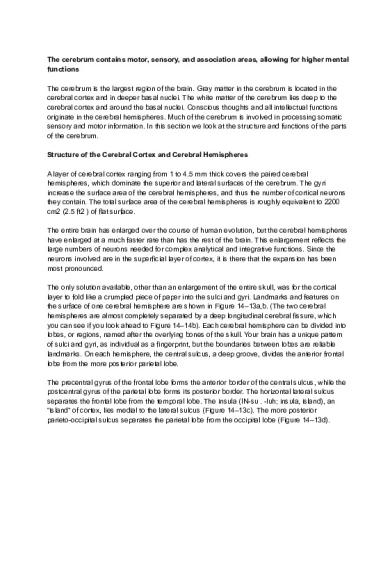The cerebrum contains motor, sensory, and association areas, allowing for higher mental functions PDF

| Title | The cerebrum contains motor, sensory, and association areas, allowing for higher mental functions |
|---|---|
| Course | Human Anatomy and Physiology with Lab I |
| Institution | The University of Texas at Dallas |
| Pages | 1 |
| File Size | 51.4 KB |
| File Type | |
| Total Downloads | 85 |
| Total Views | 132 |
Summary
The cerebrum contains motor, sensory, and association areas, allowing for higher mental functions...
Description
The cerebrum contains motor, sensory, and association areas, allowing for higher mental functions The cerebrum is the largest region of the brain. Gray matter in the cerebrum is located in the cerebral cortex and in deeper basal nuclei. The white matter of the cerebrum lies deep to the cerebral cortex and around the basal nuclei. Conscious thoughts and all intellectual functions originate in the cerebral hemispheres. Much of the cerebrum is involved in processing somatic sensory and motor information. In this section we look at the structure and functions of the parts of the cerebrum. Structure of the Cerebral Cortex and Cerebral Hemispheres A layer of cerebral cortex ranging from 1 to 4.5 mm thick covers the paired cerebral hemispheres, which dominate the superior and lateral surfaces of the cerebrum. The gyri increase the surface area of the cerebral hemispheres, and thus the number of cortical neurons they contain. The total surface area of the cerebral hemispheres is roughly equivalent to 2200 cm2 (2.5 ft2 ) of flat surface. The entire brain has enlarged over the course of human evolution, but the cerebral hemispheres have enlarged at a much faster rate than has the rest of the brain. This enlargement reflects the large numbers of neurons needed for complex analytical and integrative functions. Since the neurons involved are in the superficial layer of cortex, it is there that the expansion has been most pronounced. The only solution available, other than an enlargement of the entire skull, was for the cortical layer to fold like a crumpled piece of paper into the sulci and gyri. Landmarks and features on the surface of one cerebral hemisphere are shown in Figure 14–13a,b. (The two cerebral hemispheres are almost completely separated by a deep longitudinal cerebral fissure, which you can see if you look ahead to Figure 14–14b). Each cerebral hemisphere can be divided into lobes, or regions, named after the overlying bones of the skull. Your brain has a unique pattern of sulci and gyri, as individual as a fingerprint, but the boundaries between lobes are reliable landmarks. On each hemisphere, the central sulcus, a deep groove, divides the anterior frontal lobe from the more posterior parietal lobe. The precentral gyrus of the frontal lobe forms the anterior border of the central sulcus, while the postcentral gyrus of the parietal lobe forms its posterior border. The horizontal lateral sulcus separates the frontal lobe from the temporal lobe. The insula (IN-su . -luh; insula, island), an “island” of cortex, lies medial to the lateral sulcus (Figure 14–13c). The more posterior parieto-occipital sulcus separates the parietal lobe from the occipital lobe (Figure 14–13d)....
Similar Free PDFs

Sensory Association Cortex
- 3 Pages

7. sensory motor intergration
- 6 Pages

Higher Brain Functions quiz
- 2 Pages

Cerebrum Function.
- 5 Pages

The nature and functions of the law
- 78 Pages

The Metabo Law - Higher English
- 2 Pages

Higher Education and Aging
- 15 Pages

Motory and Sensory Development
- 4 Pages

smet functions for schools
- 2 Pages
Popular Institutions
- Tinajero National High School - Annex
- Politeknik Caltex Riau
- Yokohama City University
- SGT University
- University of Al-Qadisiyah
- Divine Word College of Vigan
- Techniek College Rotterdam
- Universidade de Santiago
- Universiti Teknologi MARA Cawangan Johor Kampus Pasir Gudang
- Poltekkes Kemenkes Yogyakarta
- Baguio City National High School
- Colegio san marcos
- preparatoria uno
- Centro de Bachillerato Tecnológico Industrial y de Servicios No. 107
- Dalian Maritime University
- Quang Trung Secondary School
- Colegio Tecnológico en Informática
- Corporación Regional de Educación Superior
- Grupo CEDVA
- Dar Al Uloom University
- Centro de Estudios Preuniversitarios de la Universidad Nacional de Ingeniería
- 上智大学
- Aakash International School, Nuna Majara
- San Felipe Neri Catholic School
- Kang Chiao International School - New Taipei City
- Misamis Occidental National High School
- Institución Educativa Escuela Normal Juan Ladrilleros
- Kolehiyo ng Pantukan
- Batanes State College
- Instituto Continental
- Sekolah Menengah Kejuruan Kesehatan Kaltara (Tarakan)
- Colegio de La Inmaculada Concepcion - Cebu






